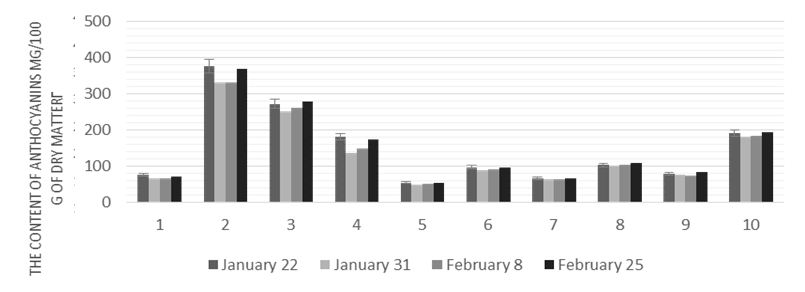CONTENT OF ANTHOCYANINS IN THE BARK OF FRUIT AND BERRY PLANTS DUE TO ADAPTION TO LOW TEMPERATURES
UDC 544.544:543.655.1
Аннотация
The most important indicator of adaptability cultivar is the winter hardiness of wood. In adverse conditions of autumn-winter period trees of many cultivars may be severely damaged and even die. At the same time, in the process of evolution, a system of adaptive reactions is formed that are associated with a deep change in metabolism and is determined by the speed and depth of its change without violating the consistency between individual functions, so that the unity of the organism and the environment is not violated. This, ultimately, determines the vital activity of the body and its endurance. At this stage of the study, it is shown how plants react to lower temperatures by changing the color of sprouts and accumulating anthocyanins. The aim of the work was to determine the winter hardiness of different cultivars of fruit plants based on physiological processes. Cultivars Malus domestica 'Era' and M. domestica 'Vydubytska plakucha' were isolated in the presence of the largest accumulation of secondary metabolites in their generative organs – 378.18–273.33 mg/100 g of dry matter, that is, they are the most plastic before adapting to abiotic factors. The Ribes uva-crispa 'Hamamekii' and Viburnum opulus genotypes with the lowest overall quantity of anthocyanins were 75.79–67.37 mg/100 g of dry matter. Based on the results of the analysis found that the highest content of anthocyanins in the cultivar Everest, and the lowest – cultivar John.
Скачивания
Metrics
Литература
Korovin F.I. Rasteniya i ekstremal'nyye temperatury. [Plants and extreme temperatures]. Leningrad, 1984, 271 p. (in Russ.).
Loladze I. Trends in Ecology & Evolution, 2002, vol. 17, pр. 457–461. DOI: 10.1016/S0169-5347(02)02587-9.
Brouillard R. Anthocyanins as food colors, New York: Academic Press, 1982, vol. 1, pр. 1–40.
Mazza G. Anthocyanins in fruits, vegetables and grains, CRC Press Inc, 1993, 362 р.
Castellarin S., Bavaresco L., Falginella L., Gonçalves M., Di Gaspero G. The biochemistry of the grape berry, Sharja: Bentham Science Publishers, 2012, pр. 89–110.
Dixon R.A., Harrison M.J., Paiva N.L. Physiologia Plantarum, 1995, vol. 93(2), pр. 385–392. DOI: 10.1111/j.1399-3054.1995.tb02243.x
Fiscus E.L., Booker F.L., Burkey K.O. Plant Cell. Environ., 1996, vol. 28, pр. 997–1011.
Noctor G., Veljovic-Jovanovic S., Driscoll S., Novitskaya L., Foyer C.H. Annals of Botany, 2002, vol. 89, pр. 841–850.
Konczak I., Zhang W. Journal of Biomedicine and Biotechnology, 2004, vol. 5, pр. 239–240.
Wrolstad R.E. J. Food. Sci., 2004, vol. 69(5), pр. 419–425.
Karabanov I.A. Flavonoidy v mire rasteniy. [Flavonoids in the plant world]. Minsk, 1981, 80 p. (in Russ.).
Mittler R. Trends in Plant Science, 2002, vol. 7, pр. 405–410.
Rhoads D.M., Umbach A.L., Subbaiah C.C., Siedow J.N. Plant Physiology, 2006, vol. 141, pр. 357–366.
Alscher R.G., Donahue J.L., Cramer C.L. Physiol. Plant., 1997, vol. 100, рp. 224–233.
Wrolstad R.E. J. Food. Sci., 2004, vol. 69(5), pр. 419–425.
Kabera J.N., Semana E., Mussa A.R., He X. Journal of Pharmacy and Pharmacology, 2014, vol. 2, pр. 377–392.
Terrier N., Ollé D., Verriès C., Cheynier V. Grapevine molecular physiology & biotechnology, Dordrecht: Springer, 2009, рp. 365–388.
Di Ferdinando M., Brunetti C., Fini A., Tattini M. Abiotic stress responses in plants: metabolism, productivity and sus-tainability. New York: Springer Science & Business Media, 2012, pр. 159–179.
Harborne J.B. Comparative photochemistry, Academic Press, London, 1996, pр. 271–295.
Kolupaev Yu.E., Karpec Yu.V. Fiziologiya i biokhimiya kul'turnykh rasteniy, 2009, Vol. 41(2), pp. 95–108. (in Russ.).
Wilkinson S., Mills G., Illidge R., Davies W.J. J. Exp. Bot., 2012, vol. 63, рp. 527–536.
Pourcel L., Routaboul J.M., Cheynier V., Lepiniec L., Debeaujon I. Trends in Plant Science, 2007, vol. 12, рp. 29–36.
Schaefer H.M., Rolshausen G. Bio. Essays., 2006, vol. 28, pр. 65–71. DOI: 10.1002/bies.20340.
Terrier N., Ollé D., Verriès C., Cheynier V. Grapevine molecular physiology & biotechnology, Dordrecht: Springer, 2009, рp. 365–388.
Fiscus E.L., Booker F.L., Burkey K.O. Plant Cell. Environ., 1996, vol. 28, pр. 997–1011.
Kriventsov V.I. Metodicheskiye rekomendatsii po analizu plodov na biokhimicheskiy sostav. [Methodical recommenda-tions for the analysis of fruits for biochemical composition]. Yalta, 1982, 21 р. (in Russ.).

Copyright (c) 2021 Химия растительного сырья

Это произведение доступно по лицензии Creative Commons «Attribution» («Атрибуция») 4.0 Всемирная.

This work is licensed under a Creative Commons Attribution 4.0 International License.
Авторы, которые публикуются в данном журнале, соглашаются со следующими условиями:
1. Авторы сохраняют за собой авторские права на работу и передают журналу право первой публикации вместе с работой, одновременно лицензируя ее на условиях Creative Commons Attribution License, которая позволяет другим распространять данную работу с обязательным указанием авторства данной работы и ссылкой на оригинальную публикацию в этом журнале.
2. Авторы сохраняют право заключать отдельные, дополнительные контрактные соглашения на неэксклюзивное распространение версии работы, опубликованной этим журналом (например, разместить ее в университетском хранилище или опубликовать ее в книге), со ссылкой на оригинальную публикацию в этом журнале.
3. Авторам разрешается размещать их работу в сети Интернет (например, в университетском хранилище или на их персональном веб-сайте) до и во время процесса рассмотрения ее данным журналом, так как это может привести к продуктивному обсуждению, а также к большему количеству ссылок на данную опубликованную работу.











